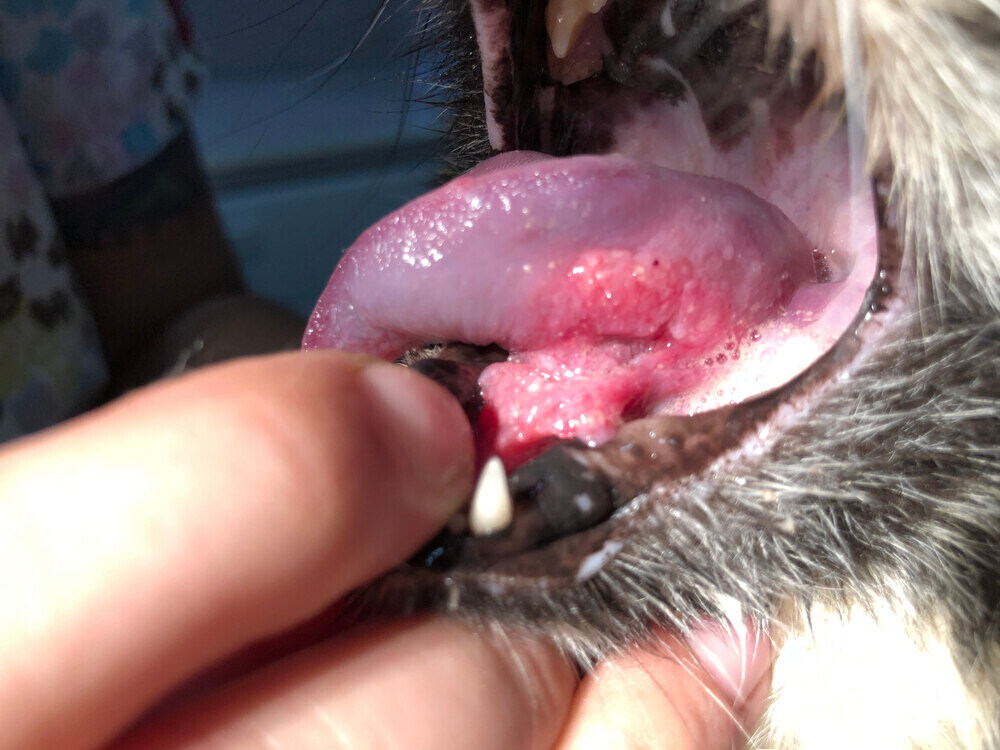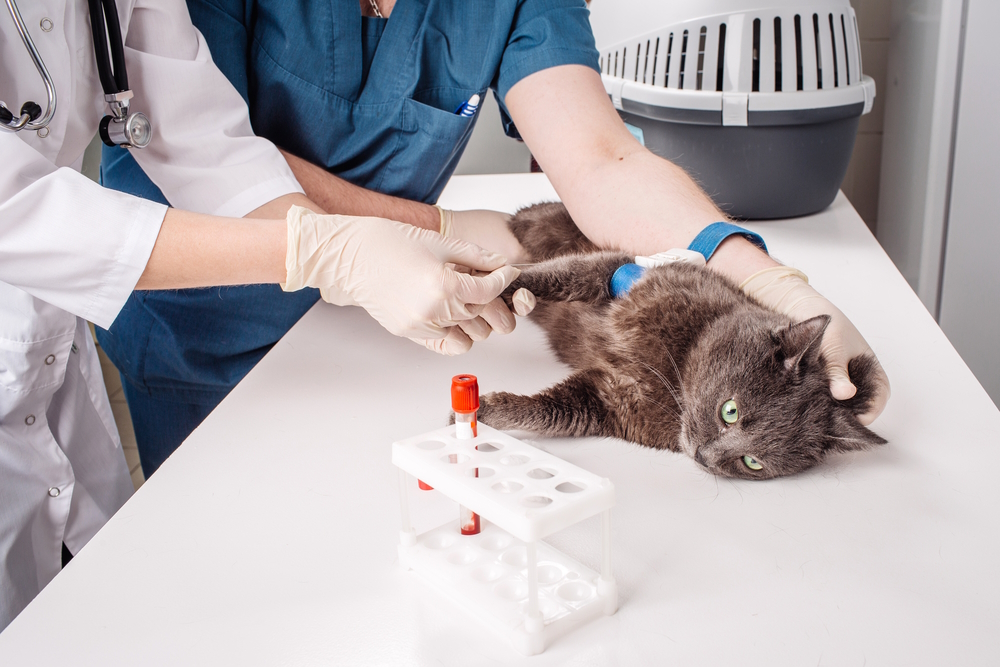Squamous cell carcinoma is a variety of locally aggressive (malignant) cancer that grows and spreads rapidly within the neighboring tissues, including on the bone level.
One of these cancer often occurs because of this of sun exposure, especially in cats with light-colored fur. Cats typically present on the vet clinic with skin ulcers, especially across the ears, eyes, and nose. If surgery is performed in time, the probabilities of survival increase.
In this text, you’ll learn what squamous cell carcinoma is, the causes of its occurrence, the clinical signs, and what you possibly can do in case your cat has squamous cell carcinoma.
What Is Squamous Cell Carcinoma?
Squamous cell carcinoma is a malignant cancer, meaning it might probably spread throughout the affected tissues and might spread to other areas. It’s an aggressive local cancer, which grows quickly and invades the neighboring tissues, including the bone.
Probably the most commonly affected cats are those between 7 and 15 years old which have been exposed to the sun for a very long time (outdoor or outdoor-indoor cats, especially those with light-colored fur). Squamous cell carcinoma commonly appears in non-pigmented areas exposed to the sun. White cats are 13 times more vulnerable to this sort of carcinoma in comparison with coloured cats.1
One of these cancer is situated in several areas of the pinnacle, corresponding to:
- Ear flaps (external pinna)
- Eyelids
- Skin of the nose
- Contained in the mouth (on the lips, under the tongue, mandible, tonsils, gums, etc.)
The diagnosis can easily be confused with benign ulcers, gingivitis, or other dental diseases, especially when accompanied by poor dental health.
In case your cat has skin ulcers or bloody lesions, take them to the vet for an accurate diagnosis and appropriate treatment. Tumors situated on the nose or ears could be noticed more easily by the owner, which ends up in earlier detection and simpler treatment.

What Are the Signs of Squamous Cell Carcinoma in Cats?
Probably the most common area where squamous cell carcinomas occur is the face, especially the ears. Other high-risk areas are those with maximum sun exposure.
Clinical signs of squamous cell carcinoma include:
- Irritation of the realm
- Weeping sores
- Crusts
- Ulceration
- Local bleeding
Signs of oral carcinoma may include:
- Lack of appetite
- Weight reduction
- Swallowing with difficulty
- Bad breath
- Excessive salivation (sometimes with blood)
In some cases, squamous cell carcinoma may appear as a raised, red area or cauliflower shape. It also has two stages:
- Initial stage: Red-pink nodular lesions appear. They’re firm in consistency, with raised edges. The carcinoma looks like a firm skin nodule.
- Advanced stage: The tumor has a variable, irregular diameter and is ulcerated. The advanced phase is commonly related to regional adenopathy (enlarged local lymph nodes).
Squamous cell carcinomas often present as a solitary lesion (i.e., it occurs in a single area). Nonetheless, there may be a variety of squamous cell carcinoma that’s often called Bowenoid carcinoma or Bowen’s disease.2 This carcinoma is a multicentric squamous cell carcinoma and occurs in several areas of the body, but isn’t technically a metastatic cancer.
When affecting the ears, squamous cell carcinoma often presents with dark, crusting lesions on the information of the ears, which can bleed or cause irritation.

What Causes Squamous Cell Carcinoma in Cats?
Any variety of tumor or cancer is the results of uncontrolled multiplication of cells. What causes this lack of control does vary and typically several changes need to occur to cells before they’ll end in the expansion of a tumor. Usually, the reason for squamous cell carcinoma in cats is the prolonged exposure of unprotected skin areas (unpigmented, hairless areas) to UV rays. The UV rays cause damage to the skin cells. Cats between the ages of seven and 15 are mostly affected by this sort of cancer.
Within the case of oral localization, squamous cell carcinoma represents roughly 80% of oral tumors reported in cats, affecting cats 12–13 years old. In comparison with the cutaneous form, oral squamous cell carcinoma is more aggressive and malignant.
How Is Squamous Cell Carcinoma Diagnosed in Cats?
An intensive general examination will highlight the presence of skin lesions. If the vet suspects squamous cell carcinoma, they’ll recommend a cytological examination. Your cat will likely be put under local or general anesthesia, and tumoral cells will likely be collected through advantageous needle aspiration. Nonetheless, for a definitive diagnosis, a biopsy may be advisable. This implies the vet will remove a bit of the tumor or excise it completely and send it to the lab for diagnosis.
Additional tests may also be advisable, corresponding to blood tests (to evaluate the overall state of health) and chest X-rays (to see if the tumor has spread to the lungs—i.e., if it has metastasized). Fortunately, metastasis is rare, but it might probably spread to the lungs, liver and kidneys. As well as, the vet can even recommend a CT scan to find out the extent of the disease, especially in cases where the cancer occurs within the mouth.
Image Credit: PRESSLAB, Shutterstock
What Are the Treatment Options for Squamous Cell Carcinoma in Cats?
Depending on the severity of the tumor and the way much it has spread to the encompassing tissues, the treatment options for squamous cell carcinoma could be the next.
- Surgical intervention: Normally, it is suggested that the excision of the tumor be done completely and widely since the reoccurrence rate for incomplete tumor resections is frequent. Within the case of oral carcinoma, this is commonly extremely difficult as a result of the placement of the tumor, and the indisputable fact that it has often grown significantly by the point it’s detected. Treatment for oral carcinoma may involve multiple modalities, besides, the prognosis is commonly poor.
- Radiation therapy: In cases where the tumor is incompletely removed, radiotherapy may help delay or prevent relapse. If the tumor has not been surgically removed, radiation therapy may help slow tumor growth.
- Cryotherapy: Freezing the tumor or tumor margins could be a useful technique for masses which are difficult to access, particularly oral carcinoma.
- Chemotherapy: One of these therapy has minimal or no advantages in treating squamous cell cancer in cats because this sort of cancer is taken into account immune to traditional chemotherapy. Nonetheless, there was some success with injecting chemotherapeutic drugs directly into the tumor itself.
- Tyrosine-kinase inhibitors (toceranib phosphate, e.g., Palladia): One of these drug controls cellular functions like replication, growth, differentiation, etc. Studies have shown that cats with squamous cell carcinoma have an extended average survival time (123 days in comparison with 45 days in cats which have not been treated with toceranib).
- Other medications: Certain medications, corresponding to COX inhibitors (non-steroidal anti-inflammatories) or buprenorphine (synthetic opioid), can increase your cat’s comfort through the analgesic effect that they’ve. Oral antibiotics may also be prescribed in case your cat has secondary infections.
How Do I Take care of a Cat With Squamous Cell Carcinoma?
In case your vet recommends surgical excision of your cat’s squamous cell carcinoma, time is of the essence. The sooner the mass is removed, the upper the possibility of success. Once the tumor grows into deeper tissues, particularly if it affects the bone, prognosis is far less favorable.
In case your cat has been diagnosed with oral squamous cell carcinoma, surgery is probably not advisable, depending on the dimensions and site of the mass. You might be referred to a veterinary oncologist to debate the choices. Even if you happen to go for palliative (end of life) treatment, which could be very reasonable with this kind of the cancer, it’s all the time good to know your options.
An important think about caring for a cat with inoperable squamous cell carcinoma is monitoring their quality of life. Anti-inflammatories and antibiotics will help to maintain them comfortable, but eventually, eating and swallowing will turn into difficult, and you have to to make a call about euthanasia.
Image Credit: Zhuravlev Andrey, Shutterstock
Regularly Asked Questions (FAQ)
What Triggers Cancer in Cats?
Several aspects can trigger cancer in cats, including UV rays, chemicals, food plan, etc. Nonetheless, normally, the causes underlying the onset of cancer in pets aren’t known. To assist reduce the risks of cancer and a variety of other diseases, it is suggested to sterilize your cat, feed them a balanced food plan, take them to periodic check-ups, and never expose them to chemicals like tobacco smoke. If you’ve got a white cat, or one with white areas on their head, one of the best thing to do is protect them from the sun. Consider keeping them indoors, and treating windows with a UV-blocking film to cut back exposure to sun-loving cats.
How Do You Feed a Cat With Squamous Cell Carcinoma?
In case your cat has been diagnosed with squamous cell carcinoma or every other variety of cancer, it’s best to feed them a food plan that’s low in carbs because they fuel the cancer cells. Your cat’s food plan must be discussed along with your veterinarian.
Image Credit: Nils Jacobi_Shutterstock
Conclusion
Squamous cell carcinoma is an aggressive cancer that may spread quickly to the encompassing tissues. This way of cancer mainly affects the information of the ears but in addition the lips, tongue, eyelids, gums, etc. The event of this sort of cancer is generally triggered by sun exposure, with white and short-haired cats being especially affected. The standard age of appearance of squamous cell carcinoma is 7–15 years.
Initially, the disease could be ignored since the skin lesions are superficial. After advancing, though, squamous cell carcinoma produces local bleeding, everlasting crusting, necrosis, and secondary infections. In the event you notice any recent lesions in your cat’s skin that aren’t going away after per week or two, take them to see your. If the tumor is capable of be completely removed, the prognosis is generally quite good. Nonetheless, in tumors which have invaded deeper tissues, or within the case of oral squamous cell carcinoma, the prognosis is mostly poor, with cats surviving 2–5 months, on average, after diagnosis.
Featured Image Credit: M. Sam, Shutterstock





